Pavlinov I.Ya. (ed.) Research in Biodiversity - Models and Applications
Подождите немного. Документ загружается.


Multiple Approach for Plant Biodiversity Conservation in Restoring Forests
229
Finally, the most recent advancements of molecular biology (identification and
characterization of ecologically important Candidate Genes, transcriptomics and
metagenomics) are highly promising but still hindered by prohibitive costs and difficulties
(Pflieger et al., 2001; Eveno et al., 2008; Derory et al., 2010).
The last procedure is based on statistical researches, starting from test areas, about
relationships between growth performance and environmental variables, such as stem
growth, bud set, flowering time, and geographic coordinates, photoperiod, altitude, etc.
These affinities are used to cluster populations according with specified range of values
calculated by statistical functions. Resulting clusters are built minimizing the distance
between the origin of propagation material and the area to under investigation.
In conclusion, all these criteria focus on reducing the risk connected with the transfer of the
material in ecologically heterogeneous areas. Such risks are evaluated in terms of adaptive
failure and undesired phenotypic traits (habitus, seed productivity, etc.), but the methods
applied are still under discussion and development. Indeed, every useful strategy devoted
to minimize the mentioned risks has to be based on a spatial delimitation consistent with the
real and/or potential adaptability of a population through the time.
The main goals to define provenances concern the species’ range, metapopulation and
subpopulation delimitation, the estimation of adaptability, and the assessment of the
adaptive effectiveness in terms of evolution. Therefore, the common methods to achieve
these goals involve a spatial-genetic clustering of at least a second generation of adult
individuals, the heterogeneity analysis of life mechanisms and functions, and the connexion
of adaptive phenotypic variability with the genetic one, developing transplant tests with
adaptive differentiation study.
In many Communitarian experiences, the definition of Regions of Provenance leaded to
delimitate large areas (e.g. oak species in Germany, Scots pine in the Baltic region), because
of the results obtained on experimental fields where the adaptive flexibility of several
populations were tested at different environmental conditions. In any case, Regions of
Provenance have to be directed to the preservation of the natural mechanisms of persistence
for a species within its range.
2.2 State of the art
In the European Union, several countries actuated the delimitation of the Regions of
Provenance for forest species after the adoption of the Directive EEC 161/71. The progress
project reports differ State by State, but practically match the requirements suggested by the
Communitarian normative. An important step concerns the mapping of species’ occurrence
in each country, and the characterization of homogeneous areas using ecological indexes. In
many cases, the Regions of Provenance have been delimited summarizing the results
obtained by the application of several clustering approaches, and taking also into account
regional and/or provincial administrative boundaries; such last conformation is particularly
useful for those countries which have commissioned the competence for environmental
topics to the local authorities.
In the following table the Member States adopting the Regions of Provenance in accordance
with the Directive 105/99 have been listed (thus, Norway has been excluded even if
adopting the Directive), providing synthetic information about used parameters and
number of target species (Table 1, modified from Alía et al., 2008). This summary table could
be subjected of updating, as the Regions of Provenance is a dynamic process still in progress
in several countries (e.g. in Italy).
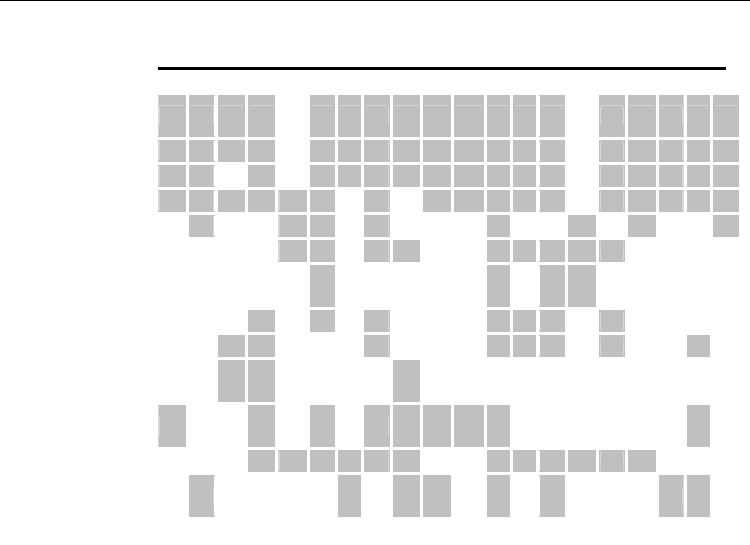
Research in Biodiversity – Models and Applications
230
Countries
Parameters
AT BE CZ DE DK ES FI FR GB GR HU IT IR LT NL PL RO SE SI SK
Geographical
information
X X X X X X X X X X X X X X X X X X
Altitude X X X X X X X X X X X X X X X X X X
Climate X X X X X X X X X X X X X X X X X
Soil X X X X X X X X X X X X X X X X X
Neutral markers X X X X X X X X
Field test X X X X X X X X X
Nursery/phytotron
test
X X X X
Growth X X X X X X X
Phenology X X X X X X X X
Resistance to
disease/pests
X X X
Vegetation/
phytogeography
X X X X X X X X X
Overall adaptation X X X X X X X X X X X X
Administrative
boundaries
X X X X X X X X
N. of target species 24 37 23 50 36 56 14 53 54 10 25 78 28 9 22 10 35 17 11 7
Table 1. Overview of the criteria adopted by the countries in the European Union that have
defined the Regions of Provenance and total amount of forest target species. Short
abbreviations of country names are given according to the ISO 3166-1-alpha-2 code.
The differences highlighted between countries suggest some critical remarks. Against a
common acceptance of the Directive 105/99, there is not a pan-European strategy for the
Regions of Provenance; some difficulties could be detected such as the available information,
the possibility to exchange, and the different formats of the data. Moreover, large differences
regard the size and the methodologies for the delineation, the number of target species and the
knowledge about their biological parameters that varies from species to species.
A standardization process devoted to set up a common approach in the delineation of the
Regions of Provenance surely will take long time, as it requires both technical and political
actions. However, it is possible to suggest improvements for the methods, using additional
ecological variables and/or techniques to explore phenological and biological behaviours of
forest species not considered yet. A study case is presented in the next paragraph and
regards the delineation of Regions of Provenance in the Latium District (Italy).
2.3 New proposals and improvements for delineating Regions of Provenance: The
case of Latium
The clustering procedure according to homogeneous environmental conditions could be
considered as the easiest approach for defining Regions of Provenance, because of the large
databases about chemo-physical parameters that each country has stored since the
beginning of the last century. Generally, we have more information about the property of a

Multiple Approach for Plant Biodiversity Conservation in Restoring Forests
231
territory instead of the living species that occur there. These simple assumptions could
justify why the divisive method is often used. Nevertheless, additional variables could be
considered for improving the delimitation of the Regions of Provenance, for instance
phytoclimatic indexes as the Mitrakos Winter Cold Stress (WCS) or Summer Drought Stress
(SDS), and the Emberger coefficient (Mitrakos, 1980; Emberger, 1955). These parameters
demand for time-series climatic data, and refer to a data point network of weather stations
widespread in an area; but, it is possible to spatially extend them by using numerical and
mathematical techniques dealing with the characterization of spatial phenomena, using
geostatistic analyses that rely on statistical approaches based on random function theory to
model the uncertainty associated with spatial estimation and simulation. Using the
geostatistic methods, as implemented in many GIS softwares, it is also possible to go beyond
the interpolation problem by considering the studied phenomenon at unknown locations as
a set of correlated random variables. In the case of Latium, both Mitrakos indexes and
Emberger coefficient have been spatialized using Kriging interpolation from 85 data points
recording precipitation and temperature for 15 years at least; topography and continentality
have been also considered as supplementary variables extrapolating data from the Digital
Elevation Model (DEM) of Italy with 75x75 m grid cells. The resulting outputs have been
overlapped to other chemo-physical variables, i.e. mean annual temperature, minimum
temperature of the coldest month, maximum temperature of the warmest month, annual
precipitation, geomorphology, soil, etc. A summary layer storing all the spatialized
variables has been performed and areas with homogeneous ecological features have been
finally detected. Moreover, the boundaries of these areas have been buffered to better
represent the gradual spatial shifting from an ecological context to another (Figure 1).
According to the main phytoclimatic parameters, as well as the vegetation maps proposed
by several authors (Blasi, 1994; Tomaselli, 1973; Pavari, 1916), Latium has been divided in 3
Primary Regions of Provenance and subsequently in 17 Secondary Regions including also
the geomorphology and the soil characteristics (Figs. 2, 3). This procedure basically follows
the common strategies adopted by the other European countries, but increases the number
of variables to be considered for a deeper ecological investigation that includes plant
response to climatic conditions.
Since the evaluation of the effects of natural selection and bioclimatic responses across space
is at the base of the definition of the Regions of Provenance, a better characterization of basic
material should be achieved by combining already showed results with parameters related
to species performance (biological responses to ecological factors) and to the altitudinal
gradient (as suggested by the Directive 105/99), in order to provide homogeneous material
both for afforestation and genetic preservation. In those countries where the knowledge
about forest species’ biological and genetic features are studied from years, or for peculiar
species with great economic impact (e.g. Populus spp., Castanea sativa Mill., Quercus petraea
Liebl., Picea abies (L.) Karst., Pinus sylvestris L., Fagus sylvatica L., Quercus suber L., etc.) such
improvements have been made; in particular, as showed in Table 1, phenology, growth
performance, and neutral markers for genetic characterization are the most used
parameters. Nevertheless, it is possible to consider further investigations focusing on
bioindicator species’ behaviours, and extending the method to all forest species.
Dendroecology can contribute to these studies by improving the analysis of tree growth
response to environmental gradients, thereby refining the classifications that are based on
climate–vegetation interactions. This approach was previously taken on 17 beech forests in
central Italy (Latium and Abruzzi) to obtain horizontal and vertical gradients in tree–climate
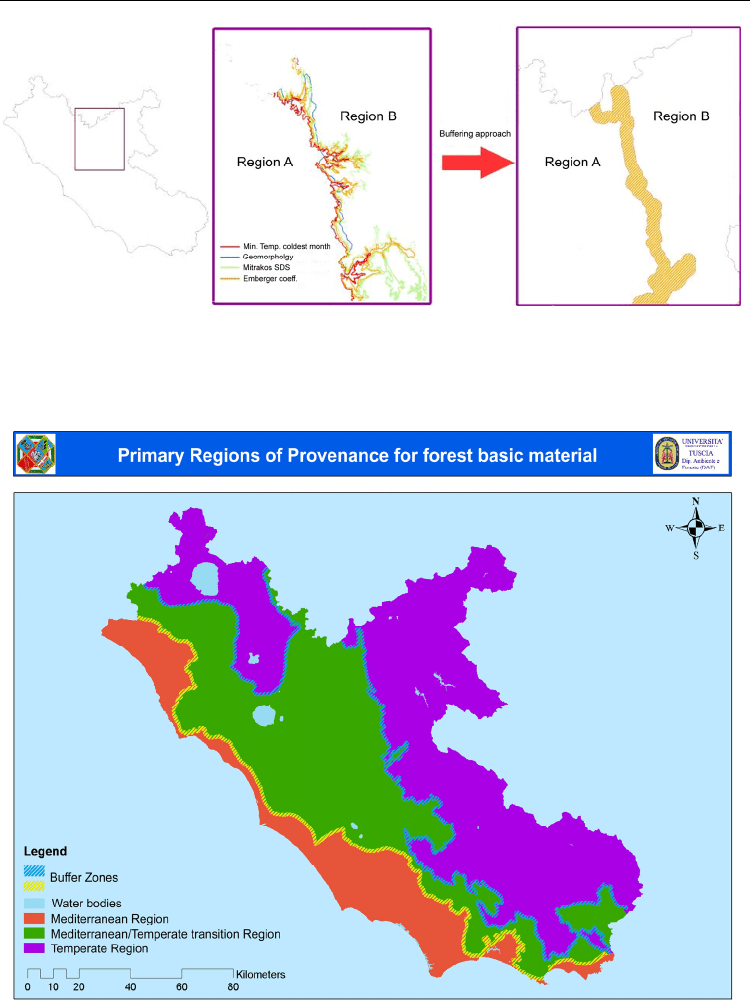
Research in Biodiversity – Models and Applications
232
Fig. 1. Example of buffered boundary between two Regions of Provenance in Latium. The
buffer zone represents a gradual transition of the ecological characteristics from Region A to
B and vice-versa.
Fig. 2. Delineation of Primary Regions of Provenance for Latium using the improvements
cited in the text.
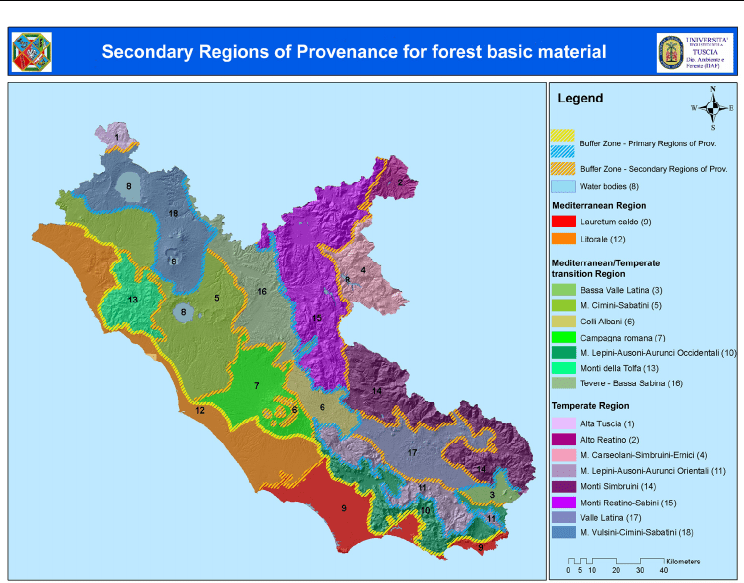
Multiple Approach for Plant Biodiversity Conservation in Restoring Forests
233
Fig. 3. Map of Secondary Regions of Provenance for Latium derived from phytoclimatic,
vegetation and chemo-physical variables.
relationships, thus providing the basis to assess bioclimatic units in terms of the leading
dendroclimatic signals (Piovesan et al., 2005). Evidence from tree-ring analysis
demonstrated that tree growth is strictly related to elevation, generating distinct beech forest
types. In agreement with previous studies (e.g. Biondi, 1992; Biondi & Visani, 1996; Dittmar
et al., 2003), distinctive radial growth–climate relationships uncovered in the tree-ring
network are organized along altitudinal and latitudinal gradients. Since beech could be
considered a good bioindicator, i.e. its dendroecological features are significantly related to
elevation, comparisons were extended to all the Latium forest surfaces, including the
altitudinal belt where beech is not present in the landscape, i.e. a non-beech belt with
bioclimatic traits that generally do not allow the growth of beech. The following results
could be considered a starting point for the selection of basic material used in genetic and
provenance studies, to accomplish the definition of the Regions of Provenance for Latium
previously showed. It is a new approach that checks the agreement between the
dendroclimatic classification and the phenological traits analyzed by remote sensing
measurements, expressed by the normalized difference vegetation index (NDVI).
The NDVI allows decadal (10 day) monitoring of terrestrial vegetation, at regional to global
scales, using the spectral reflectance measurements acquired in the red and near-infrared
regions. These spectral reflectances are themselves ratios of the reflected over the incoming
radiation in each spectral band. NDVI reflects the chlorophyll and carotenoid content in the
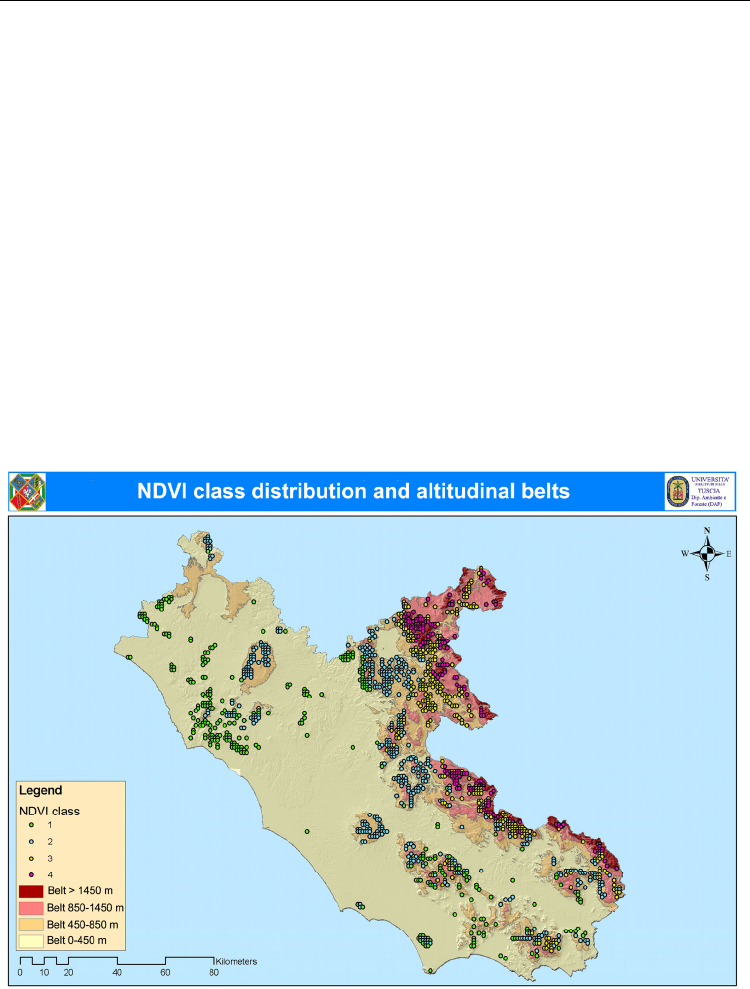
Research in Biodiversity – Models and Applications
234
leaves (Tucker & Sellers, 1986), but it is also related to leaf area index (LAI) (Fassnacht et al.,
1997) and the fraction of photosynthetically active radiation absorbed by leaves (fPAR)
(Veroustraete & Myneni, 1996). The NDVI expresses the greenness of a pixel, and it is a
good remote sensing methodology to detect interannual and seasonal changes in forest
ecosystems. Using the GIS software an NDVI time series spanning 11 years (1998–2008) was
developed. The data have a spatial resolution of 1x1km
2
. To detect the area covered by
broadleaved forests in Latium, the Corine Land Cover (CLC) database (3.1.1 classes—
Broadleaf woods) was used. Only pixels (1x1km
2
) with a forest area above 60% were used in
the analysis. Raster data were reprojected to the same coordinate system of the subset vector
grid map obtained, to overlap the CLC forest surface with satellite images. NDVI mean
values were calculated for each selected cell and partitioned using k-mean clustering. Four
fixed a priori clusters (referred to in the text as NDVI classes) were chosen to test the
correspondence with the four bioclimatic zones obtained by the dendroclimatic
classification.
The NDVI class assigned to each cell was graphically overlapped with bioclimatic
altitudinal belts, showing a good spatial correspondence between results obtained by the
dendroecological and the NDVI classification (Figure 4). The relative frequency distribution
of NDVI clustered cells per altitudinal belt ranged between 61% and 92% (Figure 5).
Fig. 4. Map of the spatial overlapping between normalized difference vegetation index
(NDVI) classes and altitudinal belts detected using the dendroclimatic approach.
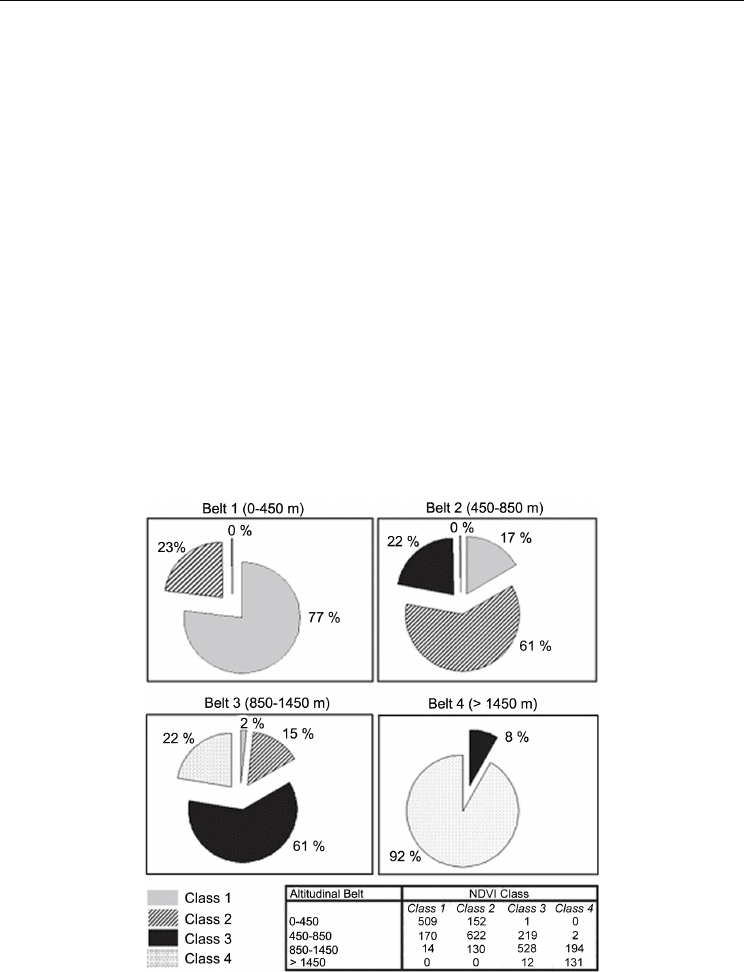
Multiple Approach for Plant Biodiversity Conservation in Restoring Forests
235
Physical parameters, such as aspect or edaphic conditions, could play a fundamental role
where other non-correspondent NDVI class cells were present. This confirmed the general
role of elevation as a key factor in controlling both the growth and phenological
behaviour of forest stands in central Italy. The NDVI varied greatly among months and
NDVI classes, stressing the difference in photosynthetic activities throughout the growing
season of distinct forest bioclimatic belts; in particular the growing season length
shortened according to increasing elevation (Figure 6). These results assess that it is
possible to link tree-ring climate signals to phenology for each altitudinal belt by
combining the two methods, adding important clues to the further comprehension and
modelling of the bioclimatic organization of these forests. The two methods were
mutually validated, and therefore would be useful in defining Regions of Provenance as
agglomerative approach. The main benefit is in providing an automated approach at local
spatial scale useful to map these regions. The coupled dendroecological application and
NDVI can offer a prompt, economic and operative tool to check and manage
homogeneous ecological areas, objectively identifying Regions of Provenance according to
plant responses. Moreover, this approach could be combined with other biological and
genetic parameters, e.g. growth performance, resistance to diseases, DNA markers, for a
wider scenario of species’ behaviour. At the same time, matching the full dataset of
ecological, biological and genetic variables a more completed delineation of Regions of
Provenance could be achieved (Alessandrini et al., 2010).
Fig. 5. Pie charts of percentage correspondence between assigned normalized difference
vegetation index (NDVI) classes and tree-ring altitudinal belts. The panel below the charts
shows the number of cells per class and belt.
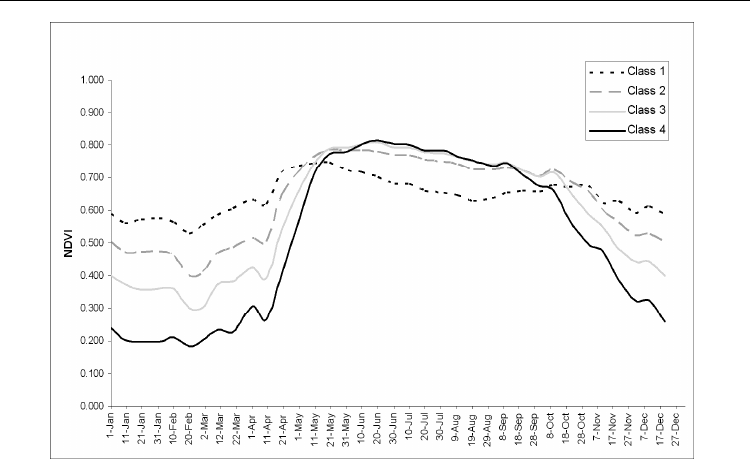
Research in Biodiversity – Models and Applications
236
Fig. 6. Annual normalized difference vegetation index (NDVI) profile of the four classes
obtained by k-means clustering.
3. DNA barcoding approach: A new challenge for species identification and
conservation
DNA barcoding is a standardized molecular approach to label living organisms by joining
specific sequences of DNA and electronic information retrieval (Hebert et al., 2003), and it
has recently become an increasingly attractive tool for species identification in terms of
accuracy, speed, cost and functionality. Ideally, a universal barcode system would be a
valuable resource to provide objective and worldwide comparable results, which can be
efficiently used in turn to compile biodiversity surveys in local floras (Lahaye et al., 2008;
Gonzalez et al., 2009; Kress et al., 2009, 2010). Additionally, the method allows the analysis
of poor, fragmented samples at any life stage (Chase et al., 2005) and it can be easily
repeated even by non-taxonomist specialists. The primary goals of barcoding are thus
species identification of known specimens and discovery of unnoticed species to enhance
taxonomy for the benefit of science and society (Kress & Erickson, 2008). The term “DNA
barcode” refers to a short DNA sequence-based identification system which may be
constructed of one locus or several loci used together as a complementary unit (Kress &
Erickson, 2007). Necessary prerequisites of DNA barcodes are ease of application across a
broad range of taxa, sufficient sequence variation to distinguish between species, and
absence of intra- and inter-specific diversity overlaps which would prevent rank definition.
Many studies have proved the efficacy of the mitochondrial cytochrome c oxidase 1 (COI or
cox1) gene sequence in barcoding animal groups such as birds (Hebert et al., 2004), fishes
(Ward et al., 2005), spiders (Greenstone et al., 2005), lepidopterans (Hajibabaei et al., 2006),
and amphibians (Smith et al., 2008), as well as in red algae (Robba et al., 2006) and fungi
(Seifert et al., 2007). In plants, the difficulty of finding a single-locus barcode has suggested a

Multiple Approach for Plant Biodiversity Conservation in Restoring Forests
237
multilocus approach, focusing on the plastid genome as currently the most effective strategy
(see Hollingsworth et al., 2009, and citations therein), although there is still much debate
concerning the most suitable regions to be used. From the broad pool of loci recently
considered (Kress et al., 2005; Chase et al., 2007; Newmaster et al., 2008; Ford et al., 2009), the
greatest interest was aroused by seven candidate plastid loci: rpoB, rpoC1 and rbcL (three
easy-to-align coding regions), a section of matK (a rapidly evolving coding region), and
trnH-psbA, atpF-atpH and psbK-psbI (three rapidly evolving intergenic spacers).
Various biological contexts (e.g., sampling strategies) have been used to compare the
performance of plant barcoding loci, and/or the efficacy of the method. A sound assessment
of the universality of regions is usually given by the “species pairs” and “floristic”
approaches. The former involves analysing pairs of related species from multiple
phylogenetically divergent genera and may be defined as a “methodological” protocol; the
latter involves sampling multiple species within a given geographical area and represents an
example of how barcoding might be applied in practice. However, only limited insights into
species-level resolution is usually provided by both approaches, as individual genera are
not sampled in depth to provide estimates of intra- and interspecific genetic distances to
achieve species identification. Conversely, a third method, the “taxon-based” approach,
involves sampling multiple species within a given taxonomic group, in a global
geographical context. This provides limited insights into universality and local applicability,
but offers more definitive information on discrimination power at species level. To date, the
species pairs (e.g. Kress et al., 2005; Kress & Erickson, 2007), and the taxon-based (e.g.
Newmaster et al., 2008; Newmaster & Ragupathy, 2009) sampling designs have provided
useful insights into the potential performance of varying combinations of barcoding loci,
whereas the floristic approach (e.g. Fazekas et al., 2008; Lahaye et al., 2008; Gonzalez et al.,
2009), has showed strong potential applicability in as many diverse research fields as
biodiversity inventories, community assembly, food and medicine identification, ethno- and
forensic botany. Based on the relative ease of amplification, sequencing, multi-alignment,
and on the amount of variation displayed (sufficient to discriminate among sister species
without affecting their correct assignation through intra-specific variation), the most
frequently recommended marker combinations for broad future applications appear to be:
rbcL + trnH-psbA (Kress & Erickson, 2007), matK + trnH-psbA (Newmaster et al., 2008;
Lahaye et al., 2008), rbcL + trnH-psbA + matK, and rbcL + matK (Consortium for the
barcode of Life, Plant Working Group [CBOL PWG], 2009).
3.1 DNA Barcoding of forest tree species
In forestry science, DNA barcodes is highly promising for the detection, monitoring and
management of biodiversity (von Crautlein et al., 2011). In addition to resolving many
taxonomic uncertainties, enhancing clear and more accurate biodiversity assessments, DNA
barcoding may provide a boost to efficient management and conservation practices, mainly
focusing on community ecology (to describe plant-animal interactions and vegetation
dynamics/changes, to discriminate native vs. alien germplasm), biodiversity inventories
(aimed at habitat and species protection), silviculture (to assess forest regeneration), and
nursery activities and market regulation (to establish wood, secondary products and
germplasm certification). The applications might be particularly relevant to manage
correctly the over-exploited and the newly identified species, to adequately protect those
having limited ranges and relatively small population sizes, as well as for mending
damaged landscapes by planning and monitor congruent reforestation programmes.

Research in Biodiversity – Models and Applications
238
Indeed, one of the future challenges for DNA barcoding in plants is to increase the number
of practical studies, and validation of the method for forestry purposes is still to be
demonstrated. Priority should be given to the use of markers with universal primers and
uniform PCR conditions. Under these criteria, the most updated recommendation from the
CBOL PWG is that rbcL+matK is adopted as the core DNA barcode for land plants (CBOL
PWG, 2009), with trnH-psbA (the next best performing plastid locus) as a supplementary
barcode option for difficult plant groups. However, success in angiosperms is often
perceived by the majority as the most important issue. For gymnosperms (and cryptogams)
the universality criterion has received little consideration up to date, and clade
specific/multiple primer sets were often used to evaluate matK and other putative barcode
markers (including rbcL and rpoC1). For instance, in the few currently available
gymnosperm-based barcoding studies, only 24% PCR success was obtained in Cycads (Sass
et al., 2007) with matK universal primers, whereas Hollingsworth et al. (2009) and Ran et al.
(2010) obtained 100% PCR and sequencing success in Araucaria and Picea by use of a
combined set of specific primers and under non-standard PCR conditions. More recently, a
taxon based study on Taxus was attempted with new matK specific primers (Liu et al., 2011).
Clearly, matK universality across both gymnosperms and angiosperms is still a matter of
concern, while rbcL and trnH-psbA have repeatedly shown strong rates of sequence
recovery in both clades but their use still requires some technical adjustments (see for
instance Hollingsworth et al., 2009).
The efficacy of the method is still under question, too. Pooled sequence data from 445
angiosperm, 38 gymnosperm, and 67 cryptogam species indicated that overall species
discrimination was successful in 72% of cases (CBOL PWG, 2009), in agreement with the
upper limit of ca. 70% resolution pointed out in previous studies (Fazekas et al., 2009;
Hollingsworth et al., 2009). Large-scale plant diversity inventories conducted at a local or
regional context matched this limit or revealed even higher percentages, although
absence/scarcity of gymnosperms in their datasets is still noticeable. Irrespective to the
statistical methods used to cluster sequences into taxonomic units, and to the marker
combinations used, <70% of species resolution was achieved on 254 angiosperm species
from an environmental sampling in Amazonia (Gonzalez et al., 2009), ca. 71% on 92
primarily angiosperm species (including 7 conifers) from selected locations of Southern
Ontario (Fazekas et al., 2008), ca. 90% on 32 angiosperm species and over 1000 orchid
species from two national parks (Lahaye et al., 2008), and 93-98% on 143 and 296
angiosperm species in community studies in tropical forest dynamics plots in Puerto Rico
and Panama (Kress et al., 2009, 2010). However, it has been shown that woody plant
lineages have consistently lower rates of molecular evolution as compared with herbaceous
plant lineages (Smith & Donoghue, 2008), suggesting that the application of DNA barcoding
concepts should be more difficult for tree than for non-woody floras (Fazekas et al., 2009).
Moreover, the discrimination rate of plastid barcoding loci varies greatly among different
plant lineages. In tree species, no resolution was achieved in 12 Quercus (Piredda et al.,
2011), 18 Betula and 26 Salix species (von Crautlein et al., 2011), whereas 30%, 63% and 100%
were achieved in Berberis (16 species), Alnus (26 species), and Compsoneura (8 species),
respectively (Roy et al., 2011; Ren et al., 2010; Newmaster et al., 2008). In Gymnosperms, all
extant five Taxus species (Liu et al., 2011) were fully discriminated with a non-standard
barcode (trnL-F); in 32 Picea species (Ran et al., 2010), the highest rate of successful
discrimination was 28.57% for a three-locus barcode (trnH-psbA, matK, atpF-atpH). A
slightly higher percentage was obtaine
d by Hollingsworth et al. (2009) in Araucaria (32%).
